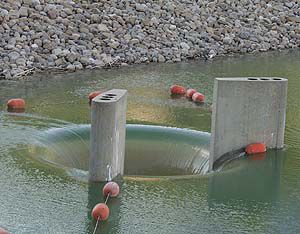| Joe’s Valley Reservoir goes over the spillway. Good winter snowpack filled reservoirs in the area including Millsite Reservoir and Electric Lake. |
Greg Marsing of the accounting firm Smuin, Rich and Marsing, was present at the Emery Water Conservancy District meeting to give the audit report. Utah State requires an audit of all government entities once a year. These audits must be completed within six months of the end of the fiscal year.
“I appreciate the opportunity to provide auditing services and work with the district,” began Marsing. He handed each board member a copy of the audit report, and explained each portion of the audit. He then pointed out the portions of the audit dealing with grant compliance and state compliance. “With the completion of this audit, I found no areas in the district that are not in compliance. Emery Water Conservancy District is in a good financial position and very solvent. The ratio of liabilities to assets is very good. This is an excellent report and the district is in a good, stable position,” concluded Marsing.
Jay Mark Humphrey gave the water report. “It’s been a good year. Joe’s Valley has just quit spilling. It worked very well to release water during April and May. The snow pack is gone with just the bigger drifts remaining. The grass on the mountain is getting dry and we could use some rain,” said Humphrey.
The board discussed the amount of shrink in the water that comes out of Joe’s Valley. Humphrey informed the board that it stands at 5 percent. The question was asked about the Huntington/Cleveland streams and the shrink there.
Following a discussion concerning Huntington/Cleveland shrink, the board decided that a firm figure is needed. Lee McElprang, board president, asked Humphrey to complete a study before the next meeting to determine the percentage of shrink in Huntington/Cleveland.
Humphrey informed the board the district has received a letter from Huntington Cleveland Irrigation Company concerning their salinity project. HCIC is requesting several modifications to the portions of the system that EWCD owns, and a change in the amount of water that is allowed to HCIC.
During the discussion of the requested changes, Humphrey said according to his figures, the requests from HCIC will cost the district 3.5 times more in maintenance than it presently costs. “It may require us to hire another person,” Humphrey said.
The board decided to respond to the letter and ask for more specific information. “Before negotiations can begin concerning these changes, we need more information,” said McElprang.
In other business by the water conservancy district, bids were opened on the sale of a dump truck by the district. Mick Rogers was the high bidder, and Humphrey will inform Rogers.
Humphrey gave his report on a cloud seeding conference he had attended. At the conference, Humphrey spoke about the district’s use of liquid propane instead of silver iodide. “We are the only ones using LP,” said Humphrey. “About cloud seeding, all the representatives from the other states are all in favor of cloud seeding, but the feds are against it,” he said. He went on to say that some states like Texas seed in the summer and others, like Utah, seed the clouds during the winter months.
The next meeting for EWCD will be held Aug. 16 at 7:30 p.m.

